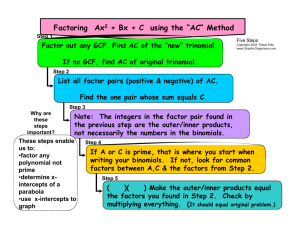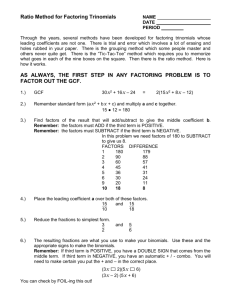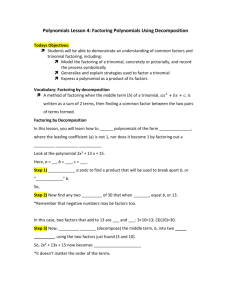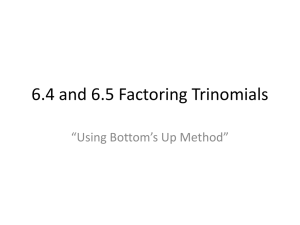Factoring Flow Chart
advertisement
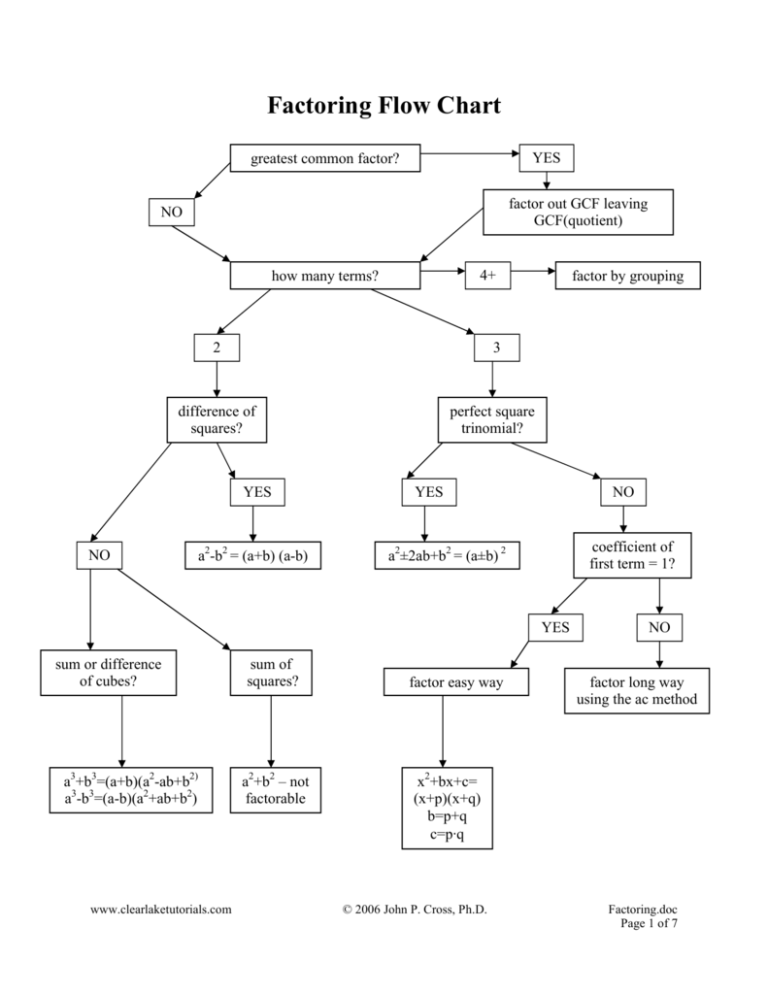
Factoring Flow Chart YES greatest common factor? factor out GCF leaving GCF(quotient) NO 4+ how many terms? 2 3 difference of squares? YES NO factor by grouping a2-b2 = (a+b) (a-b) perfect square trinomial? YES NO coefficient of first term = 1? a2±2ab+b2 = (a±b) 2 YES sum or difference of cubes? a3+b3=(a+b)(a2-ab+b2) a3-b3=(a-b)(a2+ab+b2) www.clearlaketutorials.com sum of squares? a2+b2 – not factorable factor easy way NO factor long way using the ac method x2+bx+c= (x+p)(x+q) b=p+q c=p·q © 2006 John P. Cross, Ph.D. Factoring.doc Page 1 of 7 Factoring Methods The flow chart on the first page gives you a quick reference on approaching a factoring problem. Complex factoring problems can be solved using the chart as a general guide and applying the techniques that will be discussed below. As with any concept, the way to get good at factoring is to practice it a lot. The techniques below are not intended to be a text book discussion, rather, they are intended to be “mind joggers” when you need a quick review in preparation for a test or working a problem set. Greatest Common Factor (GCF) Your first step should always be to take out any GCF. The main reason is that the remaining polynomial will be easier to factor because you have removed things that tend to hide the ultimate solution. Remember that you have to include the GCF in your factored result, it doesn’t disappear. Here’s a few problems for you to practice on. 1. 5x2 + 15x - 10 2. 7x2 + 21x + 49 3. 4x4 + 14x3 + 6x2 4. (x +2)x + (x + 2)5 5. 2x2y + 8xy - 6y 6. 3x2 + 15x - 10 7. -2x2 + 6x + 4 8. -8x3 + 18x Answers: 1. 5(x2 + 3x - 2) 2. 7(x2 + 3x + 7) 3. 2x2(x2 + 7x + 3) 4. (x + 2)(x+ 5) 5. 2y(x2 + 4x - 3) 6. no GCF 7. -2(x2 - 3x - 2) 8. -2x(x2 - 9) In problems 7 and 8 you will note that a negative number was factored out. This is normally a good practice because it is easier to factor further if the highest order term is positive. Factoring by Grouping In general, if you are faced with a polynomial of four terms, grouping is a good way to start. These are third order polynomials and this is an easy method. It is useful to have your polynomial arranged in order of exponent, with the highest on the left. You end up with a pair of binomials that can be factored out, as shown above. Here is an example: x3 + x2 + 5x + 5 (x3 + x2) + (5x + 5) Group into binomials x2(x + 1) + 5(x + 1) take out GCF from each binomial (x2 +5) (x + 1) now take out the GCF from each term www.clearlaketutorials.com © 2006 John P. Cross, Ph.D. Factoring.doc Page 2 of 7 Here are a few problems for you to try. This stuff is pretty simple. Sometimes you might have to change the order of the terms to see the answer. 1. 2x3 + x2 + 32x +16 2. ax + by + bx + ay 3. x3 + 5x2 - 4x - 20 4. x3 + xy – 6y – 6x2 Answers: 1. (x2 + 16) (2x + 1) 2. (a + b) (x +y) 3. (x – 2) (x + 2) (x + 5) 4. (x2 + y) (x - 6)) Another thing you can do by grouping is factor quadratics where the a term (in front of the x2) is not 1. I think this is the hard way to do it, so see below where the ac method is discussed. Difference of Squares This one is always easy to spot. Sometimes it is disguised a little bit and you have to think. Also remember that if you are dealing with higher order polynomials, one of the factors can sometimes be factored further. Keep trying! a2 - b2 = (a +b) (a - b) The following practice problems are a little more challenging because they mostly involve multiple steps. 1. 18x2-32 2. 27x3 - 12 xy2 3. 16x4-1 4. -9x2 + 4y2 5. x3 + x2 -144x - 144 6. x8 - y8 7. 0.25x2 - 0.49 8. x2y - z + x2z - y Answers: 1. 2(3x - 4) (3x + 4) 2. 3(3x - 2y) (3x + 2y) 3. (2x - 1) (2x+1) (4x2 + 1) 4. (2y + 3x) (2y - 3x) 5. (x + 12) (x - 12) (x + 1) 6. (x4 + y4) (x2 + y2) (x + y)(x - y) 7. (0.5x + 0.7y) (0.5x - 0.7y) 8. (x + 1) (x - 1) (y + z) Sum of Squares The sum of squares cannot be factored; we say that it is prime. Prime means that it can’t be factored further. Sum and Difference of Cubes The sum and difference of cubes can be factored: a3 - b3 = (a - b) (a2 + ab + b2) a3 + b3 = (a + b) (a2 - ab + b2) www.clearlaketutorials.com © 2006 John P. Cross, Ph.D. Factoring.doc Page 3 of 7 Here are a few practice problems (don’t forget what you have learned above): 1. 6x3 - 6y3 2. 8x3 - 27y3 3. 64 + a3 4. 2zx3 + 2z4 5. x3 + 1000 6. w3 - 0.729 7. x6 - y6 (tricky!) 8. 27x3 + z2 Answers: 1. 6(x - y) (x2 + xy + y2) 2. (2x - 3y) (4x2 + 6xy + 9y2) 3. (4 + a) (16 - 4a + a2) 4. 2z (x + z) (x2 - xz + z2) 5. (x + 10) (x2 - 10x + 100) 6. (w - 0.9) (w2 + 0.9w + 0.81) 7. (x - y) (x + y) (x2 - xy + y2) (x2 + xy + y2) 8. cannot factor Sum and Difference of Higher Order Binomials xn ± yn Where n is Not Divisible by 2 or 3 You will occasionally run into higher order binomials that can be factored in a manner like sum and difference of cubes. Here is the general solution, note that the exponents cannot be divisible by 2 or 3. If they are divisible by 2 or 3, use the rules above for other binomials. (xn + yn) = (x + y) (xn-1 - xn-2y + xn-3y2 - ….x0 yn-1) (xn - yn) = (x - y) (xn-1 + xn-2y + xn-3y2 + ….x0 yn-1) Note that the first one has alternating signs in the longer polynomial while the second has all positive signs. Polynomials of the form ax2 + bx +c - Perfect Square Trinomials A perfect square trinomial can be spotted because it fits the form: a2 ± 2ab + b2 = (a ± b)2 When the coefficient of the squared term is 1, the problem is simplified because all you have to check is that (b/2)2 = c: x2 ± bx + c = (x ± b/2)2 where (b/2)2 = c Here are a few practice problems: 1. x2 + 8x + 16 2. x2 -14x + 49 3. z2 - 2z + 1 4. x2 + 2xy + y2 www.clearlaketutorials.com 5. z2 + z + 0.25 6. 9x2 + 24x + 16 7. x2y2 + 2xyz + z2 8. 2z2 - 20z + 50 © 2006 John P. Cross, Ph.D. Factoring.doc Page 4 of 7 Answers: 1. (x + 4)2 2. (x - 7)2 3. (z - 1)2 4. (x + y)2 5. (z + 0.5)2 6. (3x + 4)2 7. (xy + z)2 8. 2 (z - 5)2 Polynomials of the form ax2 + bx +c - Non-Perfect Square Trinomials With a=1 When there is not a perfect square, you can separate the problem into two categories, depending on the value of a. The first case, where a=1, is the easiest and can be thought of as unFOILing the trinomial (remember FOIL is First, Outer, Inner, Last). It is quite simple to do using the good old guess and check method. Once you get the hang of it, you will find it is quite simple to do. The thing that gets most people in the beginning is getting the signs right. Here is a little table to help out: sign of b + + sign of c + + - signs in factors ( + ) ( + ) ( - ) ( - ) ( - ) ( + ) ( - ) ( + ) The general form of the solution to this factoring problem is: x2 + bx + c = (x + p) (x + q) where: p + q = b and p · q = c My approach to solving this one is to think of all the possible factor pairs that multiply to give the value c then go through them to see which ones add up to b. I know you just can’t wait to give this technique a try, so here are some problems to practice with: 1. x2 + 3x + 2 2. y2 - 6 - 91 3. x2 + x - 132 4. m2 + 15 + 56 5. n2 - 25 - 84 6. x2 + 13x + 12 7. b2 - 20 + 51 8. x2 + 36x + 128 Answers: 1. (x + 1) (x + 2) 2. (y - 13) (y + 7) 3. (x + 12) (x - 11) 4. (m + 7) (m + 8) 5. (n - 28) (n + 3) 6. (x + 12) (x + 1) 7. (b - 3) (b - 17) 8. (x + 32) (x + 4) www.clearlaketutorials.com © 2006 John P. Cross, Ph.D. Factoring.doc Page 5 of 7 Polynomials of the form ax2 + bx +c - Non-Perfect Square Trinomials With a>1 - the “ac” Method This is probably the toughest of the bunch to master. I have seen the method in many different books. It has been called the ac method, fishing method and go fish. I am sure there are other names. The reason I prefer to call it the ac method is that it starts by multiplying the coefficients a and c to get a trinomial to factor with a = 1 (as above). If you follow the steps very carefully, you will find that this method is quick and easy. I have chosen to show the method with a specific example rather than just using the variables because it is more evident what is going on in that way. When you master this you can amaze your classmates and teachers (and yourself). You could always use a trial and error (guess and check) method if all else fails. Example 1 Starting trinomial multiply a times c set a = 1 and c = 8 Factor the new trinomial Put the original a value in front of each x Take out any GCF Throw away the GCF and you have your answer 2x2 + 9x + 4 2·4=8 x2 + 9x + 8 (x + 8) (x + 1) (2x + 8) (2x + 1) 2(x+4) (2x + 1) (x + 4) (2x + 1) (1) (2) (3) (4) (5) (6) (7) 6x2 + x - 15 6 · -15 = -90 x2 + x - 90 (x + 10) (x - 9) (6x + 10) (6x - 9) 2(3x+5) 3(2x - 3) (3x+5) (2x - 3) (1) (2) (3) (4) (5) (6) (7) Example 2 Starting trinomial multiply a times c set a = 6 and c = -15 Factor the new trinomial Put the original a value in front of each x Take out any GCF Throw away the GCF and you have your answer Of course, you should always check your answer using FOIL. Here are some problems to practice with. Knock yourself out. 1. 6x2 + 5x + 1 2. 2y2 + 5y - 12 3. 5m2 - 9m - 2 4. 4k2 +4k - 8 www.clearlaketutorials.com 5. 4x2 - 5x + 1 6. 12t2 - t - 1 7. 6r2 -r -12 8. 45s2 +4s - 32 © 2006 John P. Cross, Ph.D. Factoring.doc Page 6 of 7 Answers: 1. (3x + 1) (2x + 1) 2. (2y - 3) (y + 4) 3. (5m + 1) (m - 2) 4. (k + 2) (4k - 4) 5. (4x - 1) (x - 1) 6. (3t - 1) (4t + 1) 7. (2r - 3) (3r +4) 8. (9s + 8) (5s - 4) A Final Thought This is by no means an exhaustive treatise on factoring. You will run into factoring problems which will use combinations of these techniques and other more advanced techniques. This discussion did not address variable exponents or substitution. I might pull that stuff together some day. www.clearlaketutorials.com © 2006 John P. Cross, Ph.D. Factoring.doc Page 7 of 7



